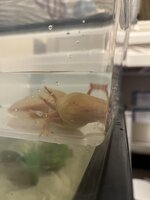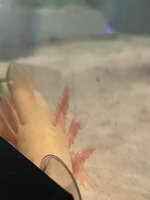Kevinjr0208
Member
- Joined
- Sep 10, 2022
- Messages
- 41
- Reaction score
- 5
- Points
- 8
- Location
- Pennsylvania
- Country
- United States
My daughters axolotl has bacterial growth on the gills. I noticed it 9/5/22 and when I saw what I needed to do for a salt bath and got the supplies the tip of the bill broke off. On 9/7/22 I cleaned the tank and did the water change, parameters were good with the water and the temp of the water was at 61.2 F. 9/8-9/9 there was no growths but on 9/10 all the gills but the previously infected one has bacteria growth. I checked the water parameters and everything is perfect. I did a salt bath with 3 tbsp salt with 2 liters of water for 10 minutes. I have the axolotl in a separate tub right now and not in the tank.
What is going on? Any suggestions?
What is going on? Any suggestions?


